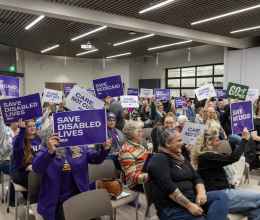
(This post originally appeared on the Huffington Post website at http://www.huffingtonpost.com/nathan-woodliffstanley-/the-mall-is-for-all_b_7852292.html?utm_hp_ref=denver&ir=Denver)
A recent article in the Denver Post raised concerns about whether enough people "linger" on the 16th Street Mall in downtown Denver. The role of the shuttles, the types of shops on the mall, and the overall environment of the mall are among factors under consideration. The focus of the article was not primarily about security or the types of people who spend time on the mall.
Nevertheless, a follow-up Denver Post editorial places blame on "transients, vagrants, panhandlers and pot users" who "congregate" on the mall, apparently spending too long there. "Lingering" is only to be desired, it seems, for a subset of the public. I suspect that the line between "lingering" and "loitering" is primarily a function of money and appearance. But the right of access to public spaces belongs to the whole public, not just a part of it.
The editorial acknowledges that security concerns are not the only reason people may not linger more on the mall, and that in fact safety concerns are more a matter of perception than reality. The mall is "hardly a hotbed of criminal activity." But because people "act on their perceptions," the editorial suggests that "police could definitely be a more visible presence on the mall."
Whatever else we do, it's a bad idea to bring in more police simply to address people's perceptions, not reality. It could backfire, too. Rather than providing reassurance, a heavy police presence could give the impression that the mall must be awfully dangerous to require so many police. It might also lead to more profiling, more unnecessary arrests for minor charges, or more harassment of people who are homeless or look like they might be.
In reality, people without a home who seek help or refuge in public places are in a vulnerable spot, far more likely to be victims of crime than a threat to others. Nonaggressive panhandling is protected speech under the First Amendment, sending a message not only about individual need but also about the worth of each person and the failures of our social structures. Our response should be to seek better ways to meet human need, not to attempt to drive away or hide from sight the people who remind us of those needs.
In any case, "vagrants" or "transients" are likely not the primary cause of insufficient "lingering" on the 16th Street Mall. The free shuttle on the mall was designed to be a key link in our public transportation system, and it fulfills that role well. The mall should be expected to have a higher rate of people simply passing through than a place not designed for that purpose.
New York City thrives as a tourist destination despite being far grittier, more diverse, and filled with greater extremes of wealth and visible poverty than the 16th Street Mall in Denver. Building on the attractions of the mall might help it more than cracking down on people identified as undesirable. We certainly should not want to replicate the racially-biased policing and excessive use of practices such as stop-and-frisk that New York is finally moving away from.
When I go to the 16th Street Mall, I find it a bustling urban corridor, a welcoming place to grab a bite to eat, and a very helpful way to get around downtown. Sometimes it is my destination and sometimes not. Either way, I have never felt unsafe. I may feel discomfort around the reality of poverty and homelessness if I see people asking for help, but that can happen anywhere, and it may be a message I need to hear. In any case, simple discomfort is not a justification for violating human rights, calling in the police, or keeping the public out of public spaces.
